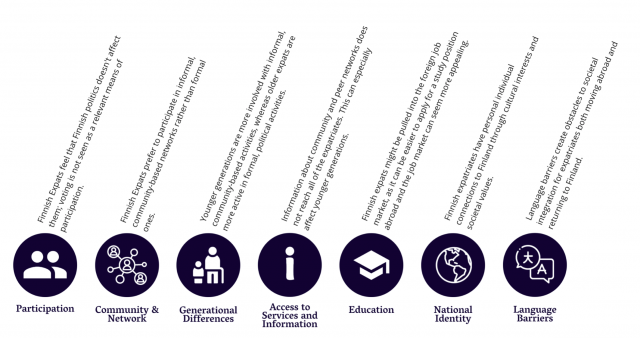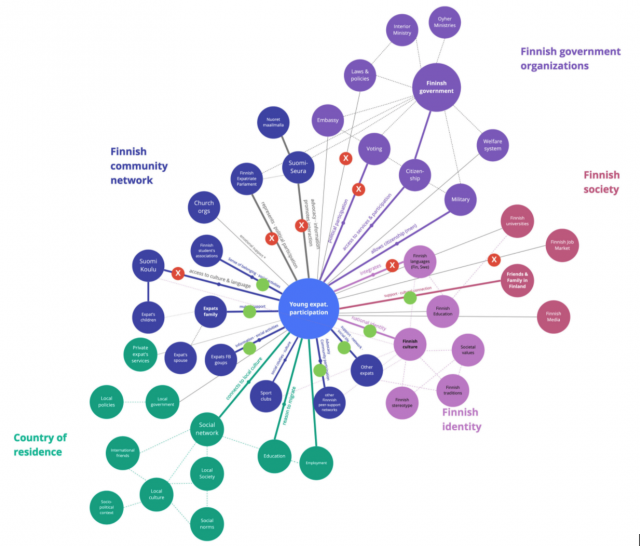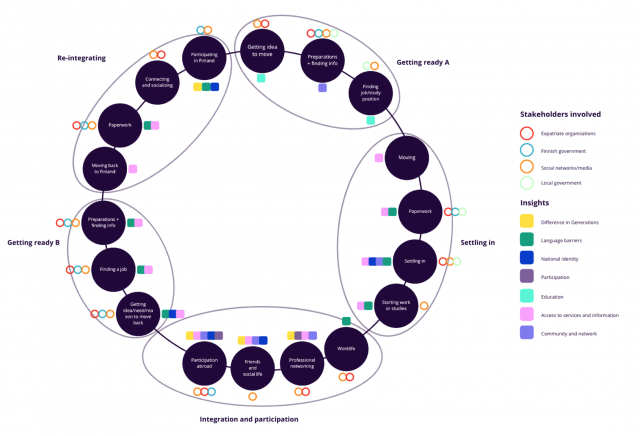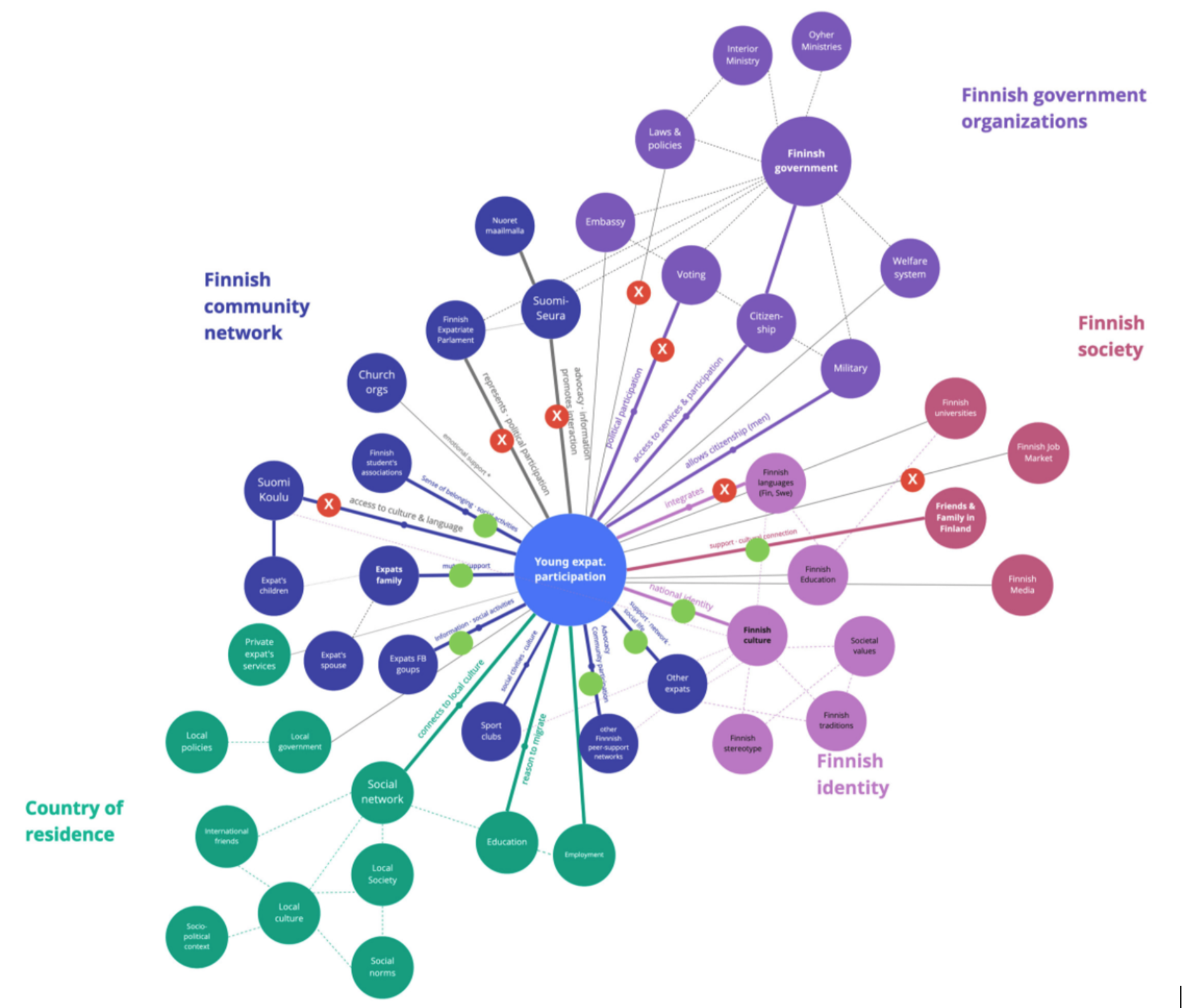This blog post reports on work-in-progress within the DfG course! The post is written by the group dealing with the Ministry of Interior’s brief on ‘Strategy for expatriate Finns’.
Group 3C: Phuong Nguyen from the New Media Design program, Mõtus Lõmaš Kama from Collaborative and Industrial Design program (Exchange), Mariela Urra Schiaffino, Creative Sustainability program (Design track), and Nicholas Colb from Information Networks program.
This blog reflects on our progress since the last post. Currently, we are at the end of the research phase of the project, and have gained an understanding of the problem context and worked to discover relevant themes, identify insights within those themes, and define our focal point to the problem.
Our research methods mainly consisted of desktop research (examining previous literature, browsing information on relevant websites, and benchmarking existing expatriate service organizations), semi-structured interviews, and an online survey. It was exciting to learn about our topic by hearing about the experiences of real people. Furthermore, it was nice to see how eager people were to share their experiences with us: most of our 7 interviews lasted for over an hour, and our online survey received more than 800 responses! Having data from the interviews, the survey, and desktop research, we mapped the key takeaways into themes into an affinity diagram and identified insights within each theme. The key insights are displayed in Figure 1:

We believe that the first four insights in particular provide grounds for narrowing down our focal point within the problem scope. The first two insights identify that Finnish expatriates prefer to participate in informal, community-based networks instead of political channels or formal organizations. One of the reasons for this is the expats feel that Finnish politics doesn’t affect them during their time abroad. Nevertheless, current services targeted toward expatriates — in particular, those provided by the government — are often aimed to promote participation through formal and political means. This phenomenon can be recognized in current interventions, such as the launch of mail-in voting and the assembly of the Finnish Expatriate Parliament. While such interventions are, undoubtedly, successful in promoting participation among some groups of expatriate Finns, our research sought to identify the groups whom these existing services fail to reach, or in other words, the groups which are underrepresented within the domain of services intended to enhance participation from abroad.
The third insight identifies younger generations as an underrepresented group in the domain of expatriate services and argues that a generational difference among preferred methods of participation exists. Both our research and previous literature on the topic suggest that younger generations prefer to be involved in looser networks and participate on a grassroots level within a community instead of engaging in institutionalized politics (Huttunen & Christinsen, 2020; Dalton, 2016). While the exact reasons behind this phenomenon remain a matter of further research, our research has identified that the current government-backed interventions to promote participation fail to appeal to young people.
“I don’t know anything about Finnish politics, I don’t even know what parties they have, I’m clueless about these things”
– Student, 23“Most of the offers sound extremely boring (like the Parliament) and more targeted for older Finnish people who live abroad. There’s nothing interesting for younger people like me” – Survey answer
“I don’t feel the need to connect with people from eg. Finnish societies, especially as usually the people in these are older than me” – Survey answer
Moreover, our fourth insight elaborates that while community-based expatriate networks are increasingly emerging, these networks remain scattered around the web, and information about them fails to reach expatriates efficiently. This seems to be because there is a lack of easy-to-access resources that would provide condensed information about these unofficial communities. The insight pinpoints information flow as a specific contributor to the problem.
“I had studied here in the UK for 5 years and had not heard of the finnish student association” – Student, 24
Based on these insights, we decided to narrow our problem down to the participation of young expatriates. We created a systems map (Figure 2) that shows relevant stakeholders within the problem domain and highlights the most relevant stakeholders as well as apparent problem areas. This systems map is intended to specify relevant stakeholders and problem areas, which will help us pinpoint opportunity areas in the solution-definition phase. Furthermore, we created a journey map (Figure 3) of the expatriate journey to help us draw the connection between our insights, relevant stakeholders and specific life events which expats undergo. The journey map helped us connect our identified insights and relevant stakeholders to concrete points in time in the overall journey of an expatriate Finn.


With our insights and analysis, we were able to narrow down the scope of the problem at hand. In conclusion, our research uncovered that current expatriate services do not address the needs of younger generations, who tend to prefer non-institutionalized participation, and further pinpointed that sluggish information flow hinders access to such service networks. Thus, the questions which remain open are: 1) How could the government promote this type of community-based participation that young people prefer, 2) How could the information about such networks be delivered efficiently, and 3) Which life events in the expat journey provide opportunity areas for novel interventions to enhance this type of participation? With these intriguing questions in mind, we proceed into the solution-definition phase of the project.
REFERENCES:
Huttunen J, Christensen HS. (2020) Engaging the Millennials: The Citizens’ Initiative in Finland. YOUNG;28(2):175-198. doi:10.1177/1103308819853055
Dalton, R. J. (2016). The good citizen: How a younger generation is reshaping American politics. Thousand Oaks, CA: SAGE Publications.
—

